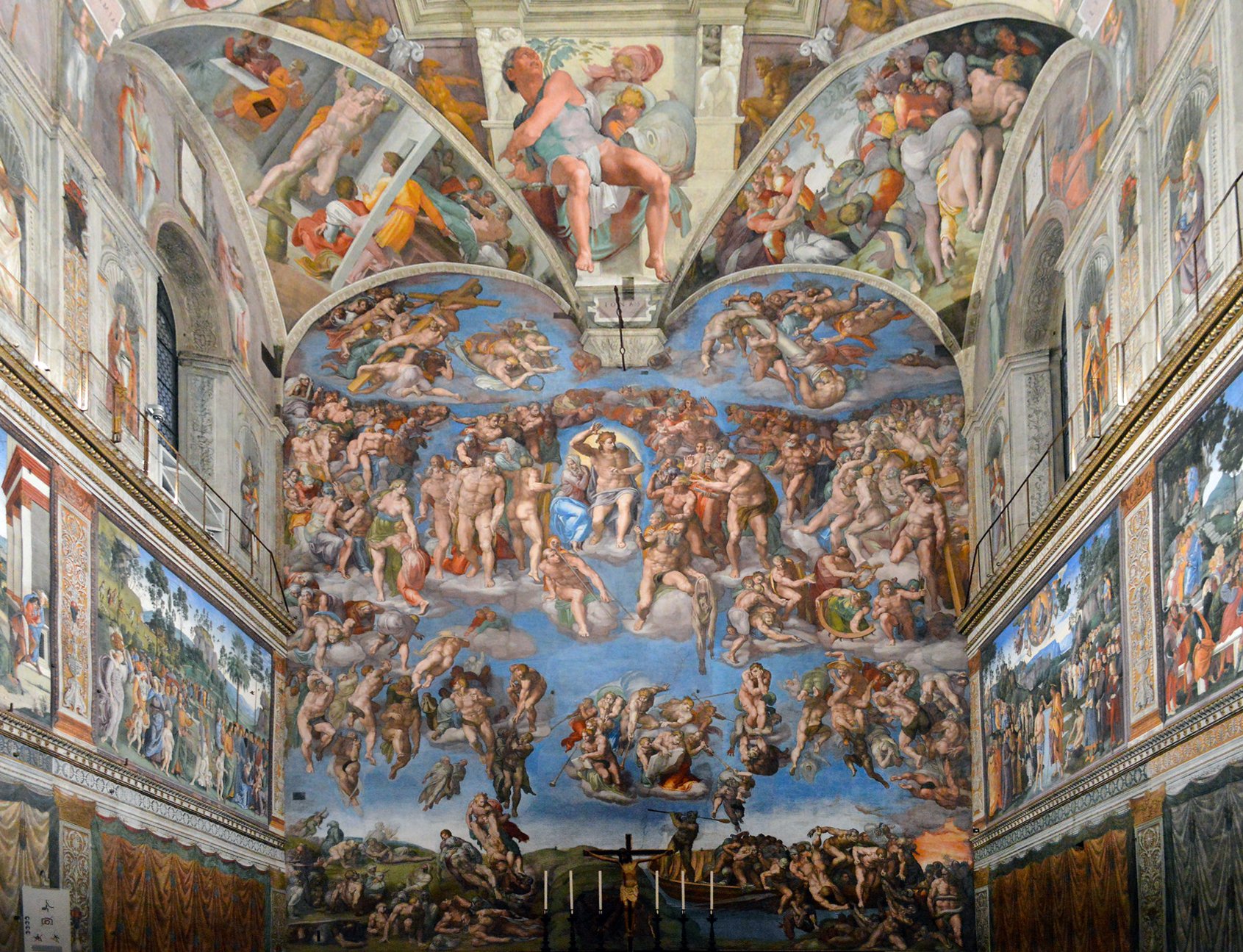The Gospel in Art: Michelangelo
By Guest Writer: Andrea McGuirt
Michelangelo, The Last Judgement
Two of my greatest passions and joys in life are art and sharing the saving gospel of Jesus Christ with others. When I gave my life fully and completely to Christ I was elated that He created me to be an artist. I was and am humbled that the Creator of heaven, earth, and all living things ordered my steps and made me a creator. What I did not know was that, rather than allowing me to stay in my studio creating alone, He would place me as a missionary in the public school system to live out my greatest passions of art and sharing Jesus with others. Teaching art history allows me to do both as we engage in the stories behind famous artists and works of art.
Michelangelo is one of the most famous names in art and arguably one of the greatest artists of all time. While he wanted to be known and remembered as a sculptor, he also established himself as a painter and architect. Recently, in art history, we studied his life and body of work. This man, who lost his mother to sickness as an infant, was turned over to be raised by his uncle at age six, skipped school as a teenager to hang out with local artists, and struggled through life with the religious teachings of the church, makes a strong connection with my students. Even though he lived 500 years before their existence, the struggles he faced are not much different from some of their own.
We discussed famous sculptures such as his Pieta and David but it was his paintings in the Sistine chapel that mesmerized my high school students. Most recently we studied The Last Judgment, a fresco painting on the back wall reaching 65 feet from floor to ceiling. The task to paint this enormous painting was given to Michelangelo by the Vatican in response to the Protestant Reformation that was marked by Martin Luther’s posting of his 95 theses and the movement that followed. The Vatican employed Michelangelo and other great Italian artists of the time to paint in this war for souls. Art was the Vatican's artillery and Michelangelo’s paint brush was positioned for war.
There is no dispute that Michelangelo’s works in the chapel is a vision of artistic beauty. Beyond that, however, it can also be overwhelming and daunting. This painting would be his most intense as he was commissioned to paint the end of time and the fate of all human souls for eternity. I teach in a government school, where the instruction within the brick and mortar must adhere to certain rules . . . and yet, GOD! Our board approved curriculum explains the painting as the meeting place of “the glories of heaven and the horrors of hell”. This massive painting boasts over 300 human figures full of emotion and movement. Jesus, the Righteous Judge, is positioned at the center toward the top of the painting with his right hand raised in judgement as he condemns the souls of those on earth. He is surrounded by saints, martyred for their faith, who rests on clouds as witnesses to the souls in judgement. At the left of the painting, blessed souls are being pulled to heaven with the help of angels and the prayers of believers. To the right, damned souls are beaten and dragged to the fires of hell by countless demons. Just below and to the right of Jesus is a man, eyes fixed on Jesus, yielding a knife in one hand and the flesh of a lifeless man in his other. The skin of the man dangles between heaven and earth positioned just above the boat carrying souls to the fires of hell. Most gripping about this skinned man is his face - it is a self portrait of the artist.. Michelangelo, in a moment of total transparency, pictured himself dangling in the balance over hell for all the world to know that he was not only uncertain of his eternal future but that he believed himself to be closer to the horrors of hell than the glories of heaven.
After our detailed discussion, I challenged my students to consider the painting and journal their personal thoughts about the artist and the work of art. The transparency they offered was gripping.
Student 1, age 17
The mood of "The Last Judgement" is very intense and dramatic. I almost get a feeling of uneasiness as if this was a big event that I would go to or is about me. When I think of the word judgement and biblical imagery I obviously think of judgement day which I imagine to be very dramatic and intense as well. The feeling of this painting is honestly evoking fear in me.
Student 2, age 16
This is a very powerful piece of art. That question being, "is what I'm doing worthy enough to make it to heaven and is my faith strong enough to get me there?" When truthfully the answer is no. No one is worthy enough to go to heaven.
Student 3, age 16
When I think about the painting, The Last Judgement, By Michelangelo, I imagine fear and horror. I'm very similar to Michelangelo in his thoughts of Christianity or religion itself, I'm not too sure of it but I don't want to go to hell if it's real. To me, too much bad has happened in my life and it just makes me think if God is as holy and powerful as the Bible says, why not make it stop? Why test your creations if you can make anything happen? I've never understood, is life for humans a game to him? I don't necessarily think of his teachings being bad, I just want to know if its genuinely real, and if it was, I would love to worship a higher power and go to an ethereal place like heaven. The right side of the painting showcases Hell and it's death angels. The eternal suffering of what is shown in the painting truly engulfs me in fear. It's horrifying and I would never want to experience that form of torment for punishment for my sins. That's why if I knew whether the religion was truthful or not, I would go out of my way to prevent any sinning and repent all forms of evil.
As I read the reactions above, and the many others from students in this particular class, I found fear to be the most common emotion experienced when the viewer takes time to truly consider the painting. I am continually amazed that art has the power to evoke such deeply meaningful and personal responses from our youth. Our state educational system mandates we look at a work of art, discuss it, and consider how we connect to a particular piece. As their teacher I have the privilege of following up with students regarding their personal thoughts and opinions of this particular work of art. Students in their search for truth, ask questions. Truth is the only thing that can calm their fears and offer the assurance of heaven and the hope that can only be found in Jesus Christ. The answer to all of their questions is in the painting. All I have to do is point to Jesus.
Soon we will critique Michelangelo’s sculpture, The Deposition (Pieta). The artist was 70 years of age when he completed this piece and was contemplating his own mortality. Like The Last Judgement, this piece also has the artist’s self portrait; this time as the face of Nicodemus who bares the weight of the dead body of Christ. This piece will allow students to research and uncover that, in this piece, Michelangelo identified himself as the man who denied Jesus as the Son of God but then changed his mind and confessed Jesus as Lord. I cannot wait to discuss Michelangelo’s change of heart and mind with students as they consider his dangling skin over hell in one painting and later, in sculpture, his belief in and confession of Jesus as Lord. My hope and prayer is that students will again connect with Michelangelo as we study his change of heart toward Jesus.


